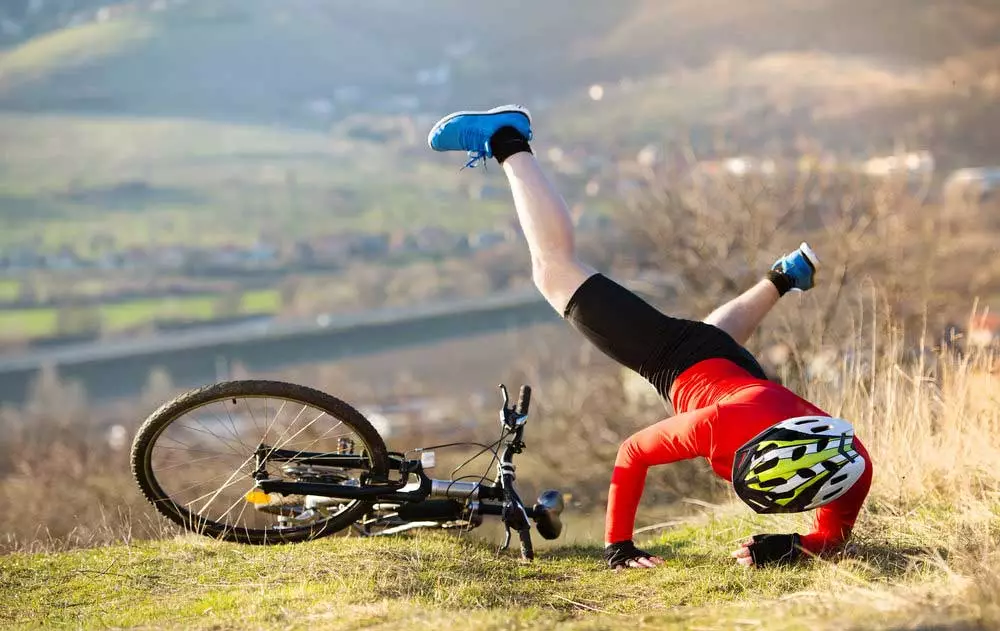Cycling is excellent exercise. Most cyclists are likely to get hurt while riding and some injuries can be severe. It is crucial to know the most frequent injuries that can happen and how to avoid them. Some of the most common cycling injuries are mentioned below.
Knee pain :– Cycling knee pain occurs from a misaligned patella or kneecap. Rest, foam rolling, and other non-invasive treatments can help in reducing pain and discomfort. Your knee should never be overextended while pedaling. Make sure your feet are pointing forwards on the pedals and the balls of your feet are in the center of the pedals.
For chronic knee pain, you can apply ice or anti-inflammatory gel to the affected area and take rest before your next ride. It can be avoided by stretching before a bike ride or by using a knee strap while riding.
Impact injuries :– A fall or other impact is the cause of many bicycle injuries, which can include concussions, fractured bones, and muscle strains. Concussions should not be taken lightly. Seek medical attention if you suffer from bleeding, extreme discomfort, or numbness.
The impact of your arm on the ground may stop you from falling and prevent a head injury, but the force is transmitted through your arm and ends at your collarbone. The collarbone takes six weeks to heal.
Strained muscles may result in overuse injuries. Road rash is the least serious but most annoying injury caused by a crash. Always clean the injury before applying antiseptic cream. Consult a doctor or visit Specialty Care Clinics for proper diagnosis and treatment. The use of ice packs can reduce swelling and pain.

Foot numbness and tingling :– Foot pain, sometimes called hot foot, is an adverse effect of cycling. Excessive pressure on your feet while pedaling can cause burning, tingling, or numbness in your feet. This common issue can be resolved by switching to wider, looser-fitting shoes.
Exertional compartment syndrome can also cause numbness in the feet. Increased pressure in the lower leg causes nerves to get compressed. Pressure measures are used to make the diagnosis, and surgical release is used to treat it.
Neck or back pain :– Staying in one riding position for a long period of time causes neck pain in cyclists. You can prevent this pain by doing exercises that release neck strain, such as shoulder shrugs and neck stretches. Low handlebars put a strain on the neck and back. Also, tight hamstrings and hip flexors can make cyclists round or arch their backs, which causes the neck to hyperextend. Regular stretching of these muscles will increase flexibility and make it easier to keep proper form.
Wrist or forearm pain :– Always ride with your elbows slightly bent. Bent elbows will serve as shock absorbers when they face road roughness. Changing hand positions here will also help in easing any discomfort or numbness.
HOW TO AVOID COMMON CYCLING INJURIES?
Ensure that your bike is properly fitted to your body. Wear comfortable shoes while riding. Always wear a helmet to help protect your head from significant damage if you fall.
Warm up :– A good warm-up increases blood flow, and oxygen to muscles, increases the temperature of the muscles, and joint range of motion which reduces the risk of tearing muscles and ligaments.
Cool down :– It can help avoid injuries and improve performance. Cool down lowers heart rate, restores muscles to their pre-exercise state by circulating blood and oxygen to them, and reduces the risk of muscle soreness.
Regular stretching of the neck, shoulders, hamstrings and hip flexors helps maintain proper form, which reduces the risk of injuries.

Protective clothing :– The helmet is the most important cycling equipment. Also, wearing gloves, and knee and elbow pads are advised, especially for cyclists.
Nutrition and hydration :– A poor diet will limit your ability to recover from workouts, increasing your risk of injury. Refueling muscles with carbohydrates is important. Muscles are rebuilt by protein. Less blood will flow through your muscles if you become dehydrated, which increases the risk of injuries.
